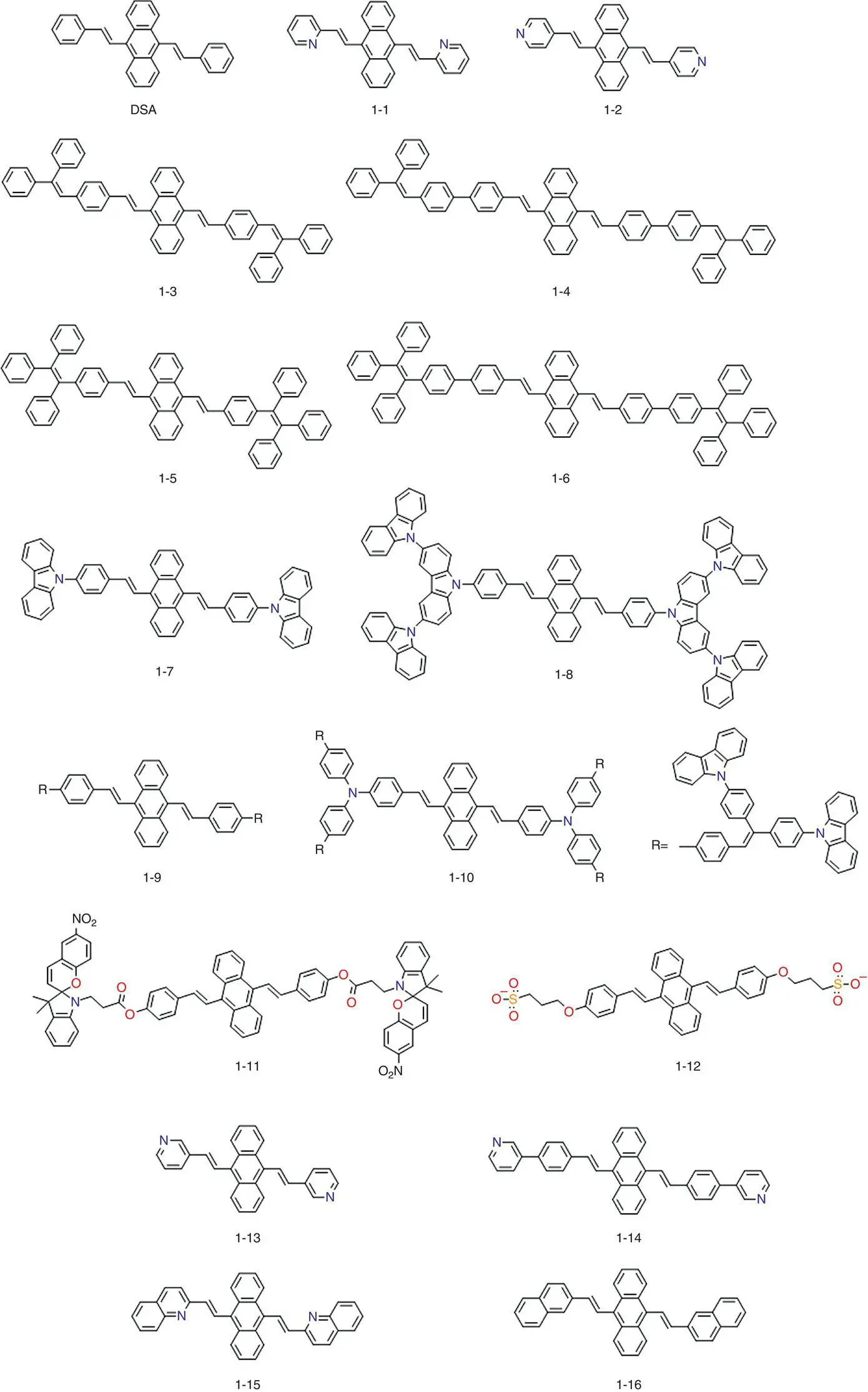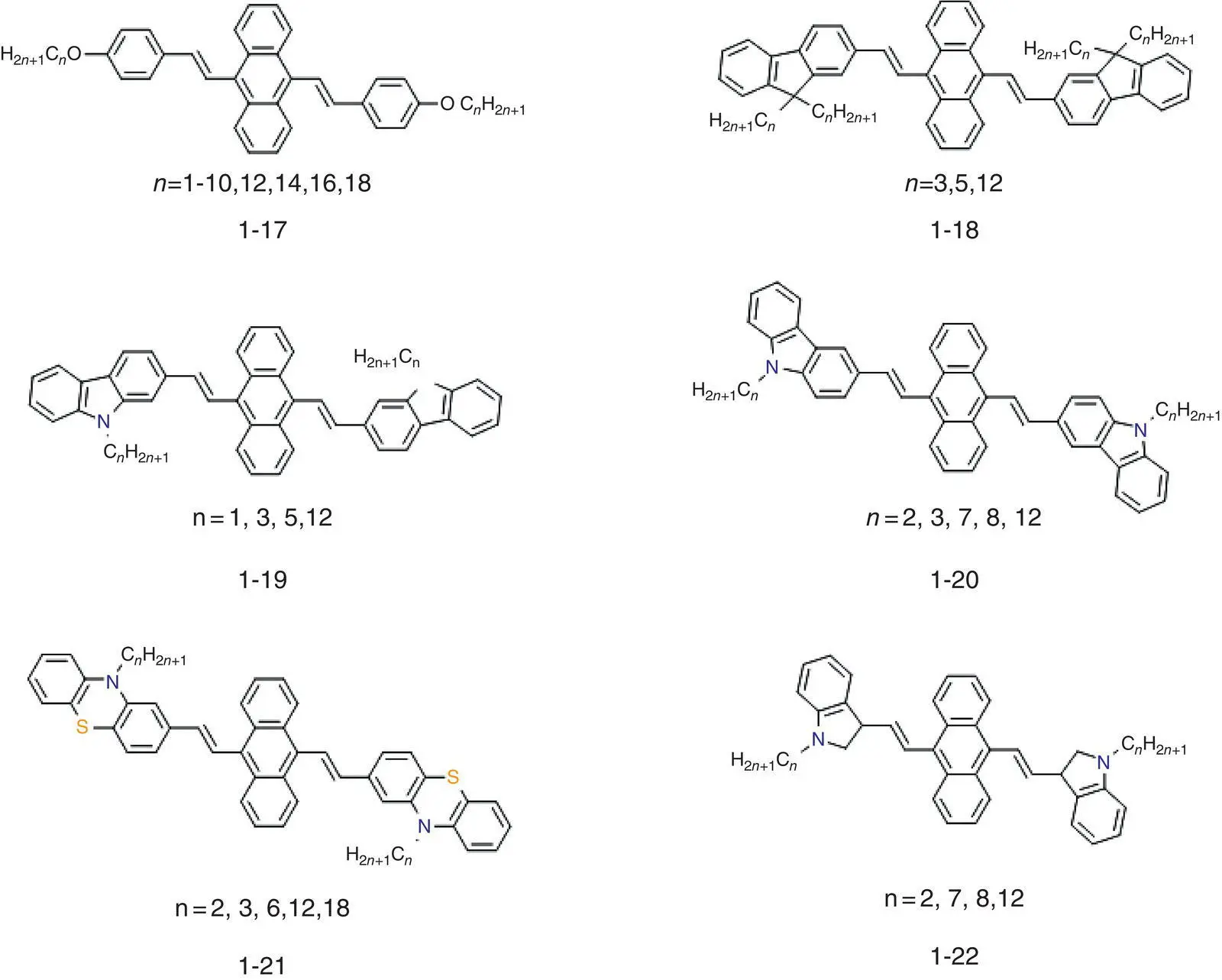Light is indispensable to human life, and it is one of the basic elements of the development of human civilization. Research on luminescent materials not only enables us to have a deep understanding of the physical process of luminescent materials but also develops the application of luminescent materials in many high‐tech fields such as fluorescence sensor, biological imaging, photodynamic therapy, organic electroluminescence, and organic solid‐state laser. These have greatly promoted the progress of human science and technology. Nowadays, more and more attention has been paid to organic luminescent materials because of their low density, low price, easy structural modification, solution processing, and so on [4]. Usually, organic luminescent materials exist in gaseous, liquid, and solid states, but in practical application, most of them exist in solid state, like film or crystal state [5–8]. Compared with the solution state, the fluorescence of organic luminescent materials generally changes greatly in the aggregation state or in the solid state. Traditional organic fluorescent dyes usually have high luminous efficiency in the solution, but after the formation of molecular aggregation, the planar molecular configuration will produce strong intermolecular π – π interaction, and the excited molecules will transition back to the ground state through nonradiation transition, thus quenching the fluorescence; this phenomenon is called as aggregation‐caused quenching (ACQ) [9–12], which limits the practical application of traditional organic fluorescent materials to a great extent.
In 2001, Tang and coworkers reported an interesting aggregation‐induced emission (AIE) phenomenon, which is completely opposite to the ACQ effect [13]. To be specific, AIE‐active molecules are almost nonemissive in dilute solution, but they show strong fluorescence emission in the aggregated states, which results in a “turn‐on” fluorescent signal. With the deepening research on AIE, it has been found that due to the free vibration and rotation of AIE molecules in dilute solution, the fluorescence of monomolecular state is weak. However, after the AIE molecules aggregate, the space hindrance caused by the twisted molecular configuration increases the distance between the luminescent centers of neighboring molecules. Therefore, the π – π interaction between molecules weakens, and the intermolecular interaction restricts the internal rotation, and resultantly the fluorescence is enhanced [14, 15].
AIE materials have strong fluorescence emission in the aggregation state, which greatly improves the performance of organic luminescent materials in practical applications. In contrast to conventional fluorescent materials, luminogens with AIE characteristics (AIEgens) exhibit many merits such as high photobleaching thresholds, stable fluorescence, and low cytotoxicity.
Up to date, many research groups have reported a variety of AIE molecules, including silole, tetraphenylethene (TPE), cyanostilbene, their derivatives, etc. [14]. Moreover, through the design of molecular structure and the control of aggregation structure, the luminescent properties of the molecules have been optimized, and the AIE material systems covering the whole visible wavelength range from dark blue to near‐infrared (IR) have been developed [16]. All of them exhibit good fluorescent efficiency to overcome the ACQ effect and display an excellent “turn‐on” characteristic in the aggregated state.
In addition to the above AIE systems, many small molecules and macromolecules based on 9,10‐distyrylanthracene (DSA) (the molecular structure of DSA is shown in Figure 2.1) and its derivatives were also developed, which have shown good AIE properties [17–22]. It was confirmed that the restriction of intramolecular rotations between the 9,10‐anthrylene core and the vinylene segment is the origin of the AIE property [23]. DSA and its derivatives have the advantages of simple structure, easy synthesis, excellent performance, etc, and have wide application potentials [24].
In this chapter, the main content focuses on the molecule systems and applications of AIE small molecules and macromolecules based on DSA. Four aspects of applications are included: smart materials with stimulus response, high solid‐state luminescent materials, fluorescent materials for bioimaging, and fluorescent probes for chemical and biological sensing.
2.2 Application of AIE Luminogens Based on 9,10‐Distyrylanthracene
2.2.1 Smart Materials with Stimulus Response
The stimulus‐responsive organic luminescent material is a kind of chromic material. The chromic material is regarded to be a type of material that can change its color automatically and the color can change reversibly when the material receives external stimulus. The external stimuli include light, electricity, heat, pressure, external force, acid, alkali, etc. The corresponding chromic materials are called photochromic, electrochromic, thermochromic, piezochromic, mechanochromic, acid chromic materials, etc. Fluorescent materials with stimulus response are widely used in many fields, such as biochemical analysis, anti‐counterfeiting labeling, solar cells, and so on. Although there have been many reports on controlling the luminescent properties of materials by using various stimuli, it is still a necessary subject to further study and adopt a simple and easy way to control the luminescent properties of materials.
Nowadays, many DSA derivatives have been applied in response luminescence upon external stimulus including piezofluorochromism, photochromism, thermochromism, acidichromism, multistimuli response, etc. Figures 2.1and 2.2show some compounds based on DSA, which exhibit excellent response luminescence upon various external stimuli.
2.2.1.1 Piezofluorochromic Materials
Piezofluorochromic material is a kind of intelligent material whose fluorescence properties change with the external pressure stimulation. They have a wide range of applications in the fields of sensor, intelligent chip, anti‐counterfeiting ink, and so on. At present, many DSA derivatives with piezofluorochromic properties have been designed and synthesized, and their remarkable piezofluorochromic properties were systematically investigated [25, 26].

Figure 2.1 Small molecules of 9,10‐distyrylanthracene (DSA) derivatives exhibiting response luminescence upon external stimulus.

Figure 2.2 Compounds based on DSA exhibiting response luminescence upon external stimulus.
Tian et al. reported that DSA derivative 1‐1(see Figure 2.1), named 9,10‐bis(( E )‐2‐(pyrid‐2‐yl)vinyl)anthracene, changed its emission color from green to yellow when the powder was under the conditions of grinding or static pressure [22]. At high pressure, the emission color of 1‐1powder eventually turns red. Through the research of single‐crystal structure, in situ high‐pressure fluorescence spectrum, and theoretical calculation, it was found that the shift in fluorescence emission from green to red results from the enhanced π – π interaction between adjacent anthracene planes in the crystal and increased exciton coupling and orbital overlap between neighboring molecules. The powder of DSA derivative 1‐2(see Figure 2.1) [27] has the same fluorescence change after grinding and will change to the initial state after heating at 170 °C for about 20 minutes.
Читать дальше














